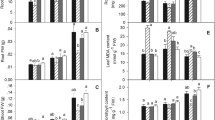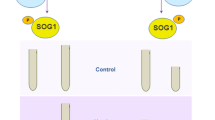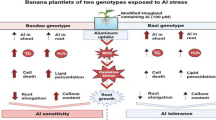Abstract
In acidic soils (pH < 5.0), aluminum (Al) occurs as Al3+, which is phytotoxic and reduces the root growth by hormonal imbalance and/or cell wall rigidity. However, the explanations for the decrease in root growth are not clear. A 60-day study was held with ‘Rangpur’ lime (Citrus limonia) plants grown in nutrient solution containing 0 and 1480 µM Al. We measured plant biometric data and used root apices to analyze auxin (IAA), the expression of some Al-responsive genes that had been differentially expressed in a transcriptome analysis and anatomical profiles. We found up-regulated expression of multidrug and toxic compound exudation (Cl-MATE channel), citrate synthase (Cl-CS) and pectin methylesterase inhibitor (Cl-PMEI) genes, but while Cl-PMEI expression was increased after 7 days, Cl-CS and Cl-MATE were up-regulated only after 60 days, suggesting that the timing of these events was ineffective against Al. These results could be associated with the Al-induced decrease in root growth and anatomical root damage. In addition, genes related to IAA cell transport were not differentially expressed in the transcriptome analysis. Therefore, high IAA and up-regulation of auxin-related small RNAs suggest Al-induced high IAA concentration rather than Al-induced disruption in IAA distribution in root cells of this species.









Similar content being viewed by others
References
Andrews S (2010) FastQC: a quality control tool for high throughput sequence data
Banhos OFAA, Brenda M, de O, da Veiga EB, Bressan ACG, Tanaka FAO, Habermann G (2016) Aluminum-induced decrease in CO2 assimilation in ‘Rangpur’lime is associated with low stomatal conductance rather than low photochemical performances. Sci Hortic 205:133–140
Blamey FPC, Kopittke PM, Wehr JB, Menzies NW (2011) Recovery of cowpea seedling roots from exposure to toxic concentrations of trace metals. Plant soil 341:423–436
Bressan ACG, Coan AI, Habermann G (2016) X-ray spectra in SEM and staining with chrome azurol S show Al deposits in leaf tissues of Al-accumulating and non-accumulating plants from the cerrado. Plant Soil 404:293–306. https://doi.org/10.1007/s11104-016-2841-1
Brunner I, Sperisen C (2013) Aluminum exclusion and aluminum tolerance in woody plants. Front Plant Sci 4:1–12. https://doi.org/10.3389/fpls.2013.00172
Chen L, Qi Y, Liu X-H (2005) Effects of aluminum on light energy utilization and photoprotective systems in citrus leaves. Ann Bot 96:35–41
Clark RB (1975) Characterization of phosphatase of intact maize roots. J Agric Food Chem 23:458–460
Cleland RE (2010) Auxin and cell elongation. In: Davies PJ (ed) Plant hormones—biosynthesis, signal transduction action! Springer, Ithaca, pp 204–220
Delhaize E, Hebb DM, Ryan PR (2001) Expression of a Pseudomonas aeruginosa citrate synthase gene in tobacco is not associated with either enhanced citrate accumulation or efflux 1. Plant Physiol 125:2059–2067
Evans ML, Ishikawa H, Estelle MA (1994) Responses of Arabidopsis roots to auxin studied with high temporal resolution: comparison of wild type and auxin-response mutants. Planta 194:215–222
Fischer E, Speier A (1895) Darstellung der ester. Eur J Inorg Chem 28:3252–3258
Franco CR, Chagas AP, Jorge RA (2002) Ion-exchange equilibria with aluminum pectinates. Colloids Surf A 204:183–192
Furukawa J, Yamaji N, Wang H, Mitani N, Murata Y, Sato K, Katsuhara M, Takeda K, Ma JF (2007) An aluminum-activated citrate transporter in barley. Plant Cell Physiol 48:1081–1091. https://doi.org/10.1093/pcp/pcm091
Giovane A, Servillo L, Balestrieri C, Raiola A, Avino RD, Tamburrini M (2004) Pectin methylesterase inhibitor. Biochim Biophys Acta 1696:245–252. https://doi.org/10.1016/j.bbapap.2003.08.011
Hager A (2003) Role of the plasma membrane H+-ATPase in auxin-induced elongation growth: historical and new aspects. J Plant Research 116:483–505
Horst WJ, Wang Y, Eticha D (2010) The role of the root apoplast in aluminium-induced inhibition of root elongation and in aluminium resistance of plants: a review. Ann Bot 106:185–197
Huang J-H, Cai Z-J, Wen S-X, Guo P, Ye X, Lin G-Z, Chen L-S (2014) Effects of boron toxicity on root and leaf anatomy in two Citrus species differing in boron tolerance. Trees 28:1653–1666
Jain M, Tyagi AK, Khurana JP (2006) Genome-wide analysis, evolutionary expansion, and expression of early auxin-responsive SAUR gene family in rice (Oryza sativa). Genomics 88:360–371
Jiang H-X, Chen L-S, Zheng J-G, Han S, Tang N, Smith BR (2008) Aluminum-induced effects on photosystem II photochemistry in Citrus leaves assessed by the chlorophyll a fluorescence transient. Tree Physiol 28:1863–1871
Karnovsky MJ (1965) A formaldehyde-glutaraldehyde fixative of high osmolarity for use in electron microscopy. J Cell Biol 27:137–139
Kochian LV (1995) Cellular mechanisms of aluminum toxicity and resistance in plants. Ann Rev Plant Biol 46:237–260
Kopittke PM, Blamey FPC, Menzies NW (2008) Toxicities of soluble Al, Cu, and La include ruptures to rhizodermal and root cortical cells of cowpea. Plant Soil 303:217–227
Langmead B, Salzberg SL (2012) Fast gapped-read alignment with Bowtie 2. Nat Methods 9:357–359
Li B, Dewey CN (2011) RSEM: Accurate transcript quantification from RNA-Seq data with or without a reference genome. BMC Bioinfor 12:323–338
Liu J, Magalhaes JV, Shaff J, Kochian LV, Maize E, Lagoas S, Grosso M (2009) Aluminum-activated citrate and malate transporters from the MATE and ALMT families function independently to confer Arabidopsis aluminum tolerance. Plant J 57:389–399. https://doi.org/10.1111/j.1365-313X.2008.03696.x
Liu MY, Chen WW, Xu JM, Fan W, Yang JL, Zheng SJ (2013) The role of VuMATE1 expression in aluminium-inducible citrate secretion in rice bean (Vigna umbellata) roots. J Exp Bot 64:1795–1804. https://doi.org/10.1093/jxb/ert039
Ludwig-Müller J, Georgiev M, Bley T (2008) Metabolite and hormonal status of hairy root cultures of Devil’s claw (Harpagophytum procumbens) in flasks and in a bubble column bioreactor. Process Biochem 43:15–23
Lüthen H, Böttger M (1993) The role of protons in the auxin-induced root growth inhibition-A critical reexamination. Plant Biology 106:58–63
Ma JF (2000) Role of organic acids in detoxification of aluminum in higher plants. Plant Cell Physiol 41:383–390
Ma JF, Nagao S, Sato K, Ito H, Furukawa J, Takeda K (2004) Molecular mapping of a gene responsible for Al-activated secretion of citrate in barley. J Exp Bot 55:1335–1341. https://doi.org/10.1093/jxb/erh152
Mafra V, Kubo KS, Alves-Ferreira M, Ribeiro-Alves M, Stuart RM, Boava LP, Rodrigues CM, Machado MA (2012) Reference genes for accurate transcript normalization in citrus genotypes under different experimental conditions. PloS ONE 7:e31263
Magalhaes JV (2010) How a microbial drug transporter became essential for crop cultivation on acid soils: aluminium tolerance conferred by the multidrug and toxic compound extrusion (MATE) family. Ann Bot 106:199–203. https://doi.org/10.1093/aob/mcq115
McClure BA, Hagen G, Brown CS, Gee MA, Guilfoyle TJ (1989) Transcription, organization, and sequence of an auxin-regulated gene cluster in soybean. Plant Cell 1:229–239
McKenna A, Hanna M, Banks E, Sivachenko A, Cibulskis K, Kernytsky A, Garimella K, Altshuler D, Gabriel S, Daly M (2010) The genome analysis toolkit: a MapReduce framework for analyzing next-generation DNA sequencing data. Genome Res 20:1297–1303
O’brien TP, Feder N, McCully ME (1964) Polychromatic staining of plant cell walls by toluidine blue O. Protoplasma 59:368–373
Pereira WE, Siqueira DL de, Puiatti M, Martínez CA, Salomão LCC, Cecon PR (2003) Growth of citrus rootstocks under aluminium stress in hydroponics. Sci Agric 60:31–41
Rahman A, Bannigan A, Sulaman W, Pechter P, Blancaflor EB, Baskin TI, Division PB, Roberts S, Foundation N (2007) Auxin, actin and growth of the Arabidopsis thaliana primary root. Plant J 50:514–528. https://doi.org/10.1111/j.1365-313X.2007.3068.x
Rangel AF, Rao IM, Horst WJ (2009) Intracellular distribution and binding state of aluminum in root apices of two common bean (Phaseolus vulgaris) genotypes in relation to Al toxicity. Physiol Plant 135:162–173
Ribeiro RV, Machado EC (2007) Some aspects of citrus ecophysiology in subtropical climates: re-visiting photosynthesis under natural conditions. Braz J Plant Physiol 19:393–411
Ryan PR, Ditomaso JM, Kochian LV (1993) Aluminium toxicity in roots: an investigation of spatial sensitivity and the role of the root cap. J Exp Bot 44:437–446
Ryan PR, Tyerman SD, Sasaki T, Furuichi T, Yamamoto Y, Zhang WH, Delhaize E (2011) The identification of aluminium-resistance genes provides opportunities for enhancing crop production on acid soils. J Exp Bot 62:9–20
Santos CHdos, Hú GF, Rodrigues JD, Pinho SZ de (2000) Influence of different levels of aluminum on the development of citrus rootstock swingle citrumelo (Citrus paradisi mcf. x Poncirus trifoliata raf.) in nutrient solution. Braz Arch Biol Technol 43:0
Sarruge JR, Haag HP (1974) Análises químicas em plantas. Escola Superior de Agricultura “Luiz de Queiroz”. Boletim Técnico, Piracicaba
Sasaki T, Yamamoto Y, Ezaki B, Katsuhara M, Ahn SJ, Ryan PR, Delhaize E, Matsumoto H (2004) A wheat gene encoding an aluminum-activated malate transporter. Plant J 37:645–653. https://doi.org/10.1111/j.1365-313X.2003.01991.x
Schmohl N, Pilling J, Fisahn J, Horst WJ (2000) Pectin methylesterase modulates aluminium sensitivity in Zea mays and Solanum tuberosum. Physiol Plant 109:419–427. https://doi.org/10.1034/j.1399-3054.2000.100408.x
Shaff JE, Schultz BA, Craft EJ, Clark RT, Kochian LV (2010) GEOCHEM-EZ: a chemical speciation program with greater power and flexibility. Plant soil 330:207–214
Spartz AK, Ren H, Park MY, Grandt KN, Lee H, Murphy AS, Sussman MR, Overvoorde PJ, Gray WM (2014) SAUR inhibition of PP2C-D phosphatases activates plasma membrane H + - ATPases to promote cell expansion in Arabidopsis. Plant Cell 26:2129–2142. https://doi.org/10.1105/tpc.114.126037
Stass A, Wang Y, Eticha D, Horst WJ (2006) Aluminium rhizotoxicity in maize grown in solutions with Al3 + or Al (OH) 4—as predominant solution Al species. J Exp Bot 57:4033–4042
Sun P, Tian Q, Chen J, Zhang W (2010) Aluminium-induced inhibition of root elongation in Arabidopsis is mediated by ethylene and auxin. J Exp Bot 61:347–356. https://doi.org/10.1093/jxb/erp306
Swarup R, Perry P, Hagenbeek D, Van Der Straeten D, Beemster GTS, Sandberg G, Bhalerao R, Ljung K, Bennett MJ (2007) Ethylene upregulates auxin biosynthesis in Arabidopsis seedlings to enhance inhibition of root cell elongation. Plant Cell 19:2186–2196
Tarazona S, García-Alcalde F, Dopazo J, Ferrer A, Conesa A (2011) Differential expression in RNA-seq: a matter of depth. Genome Res 21:2213–2223
Von Uexküll HR, Mutert E (1995) Global extent, development and economic impact of acid soils. In: Date RA (ed) Plant Soil interactions at low pH. Kluwer Academic Publishers, Dordrecht, pp 5–19
Wagner GP, Kin K, Lynch VJ (2012) Measurement of mRNA abundance using RNA-seq data: RPKM measure is inconsistent among samples. Theor Biosci 131:281–285
Wang J, Chen D, Lei Y et al (2014) Citrus sinensis annotation project (CAP): a comprehension database for sweet orange genome. PLoS ONE 9:e87723
Xu M, You J, Hou N, Zhang H, Chen G (2010) Mitochondrial enzymes and citrate transporter contribute to the aluminium-induced citrate secretion from soybean (Glycine max) roots. Funct Plant Biol 37:285–295
Yang L-T, Jiang H-X, Tang N, Chen L-S (2011) Mechanisms of aluminum-tolerance in two species of citrus: secretion of organic acid anions and immobilization of aluminum by phosphorus in roots. Plant Sci 180:521–530
Yang Z, Geng X, He C, Zhang F, Wang R, Horst WJ, Ding Z (2014) TAA1-regulated local auxin biosynthesis in the root-apex transition zone mediates the aluminum-induced inhibition of root growth in Arabidopsis. Plant Cell 26:2889–2904. https://doi.org/10.1105/tpc.114.127993
Zhao Z, Feng JM, Kazuhiro M (2003) Differential Al resistance and citrate secretion in barley (Hordeum vulgare L.). Planta 1395:794–800. https://doi.org/10.1007/s00425-003-1043-2
Zhbannikov IY, Hunter SS, Foster JA, Settles ML (2017) SeqyClean: a pipeline for high-throughput sequence data preprocessing. In Proceedings of the 8th ACM International Conference on Bioinformatics, Computational Biology, and Health Informatics, pp 407–416. (ACM)
Zhu XF, Sun Y, Zhang BC, Mansoori N, Wan JX, Liu Y, Wang ZW, Shi YZ, Zhou YH, Zheng SJ (2014) TRICHOME BIREFRINGENCE-LIKE27 affects aluminum sensitivity by modulating the O-acetylation of xyloglucan and aluminum-binding capacity in arabidopsis. Plant Physiol 166:181–189. https://doi.org/10.1104/pp.114.243808
Acknowledgements
We acknowledge the Brazilian National Council for Scientific and Technological Development (CNPq) for financial support (474169/2013-8 grant to GH), for an undergraduate scholarship to M.F. Cavalheiro and for research fellowships granted to G. Habermann (Grant 309149/2017-7) and E. Purgatto (Grant 305458/2013-2). We extend acknowledgments to the São Paulo Research Foundation (Fapesp) for PhD scholarships granted to C.M.S. da Silva (Fapesp #2013/11370-3), A.C.G. Bressan (Fapesp #2014/14386-0), a MSc scholarship to B.M.O. Carvalho (Fapesp #2016/14216-3) and a grant to E. Purgatto (Fapesp #2013/07914-8), and also to the Coordination for Improvement of Graduate Personnel (Capes) for a PhD scholarship granted to O.F.A.A. Banhos. We thank the Sanicitrus Nursery (Araras, São Paulo state, Brazil) for providing us with the ‘Rangpur’ lime plants.
Author information
Authors and Affiliations
Corresponding author
Electronic supplementary material
Below is the link to the electronic supplementary material.
Rights and permissions
About this article
Cite this article
Silva, C.M.S., Cavalheiro, M.F., Bressan, A.C.G. et al. Aluminum-induced high IAA concentration may explain the Al susceptibility in Citrus limonia. Plant Growth Regul 87, 123–137 (2019). https://doi.org/10.1007/s10725-018-0458-5
Received:
Accepted:
Published:
Issue Date:
DOI: https://doi.org/10.1007/s10725-018-0458-5




